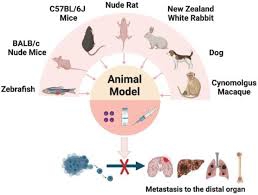Cancer research is an ever-evolving field, striving to uncover the complexities of tumor biology and develop effective therapies. One of the most indispensable tools in this endeavor is the use of animal tumor models. These models bridge the gap between basic science and clinical application, providing insights into how cancer behaves in living organisms and how it might respond to potential treatments.
What Are Animal Tumor Models?
Animal tumor models involve the use of laboratory animals, such as mice, rats, or zebrafish, to study cancer development, progression, and treatment. These models can simulate various aspects of human cancer, including tumor growth, metastasis, and interactions with the immune system. They are foundational for exploring the mechanisms of cancer and testing new therapeutic strategies before clinical trials in humans.
Types of Animal Tumor Models
1. Spontaneous Models
In spontaneous tumor models, animals naturally develop cancers due to genetic predisposition or aging. These models closely mimic the natural progression of human cancers, making them valuable for studying tumor initiation and evolution.
2. Chemically Induced Models
Exposure to carcinogenic substances induces tumor formation in animals. These models are often used to study the effects of environmental factors on cancer development and to identify potential preventive strategies.
3. Xenograft Models
Xenograft models involve transplanting human tumor cells or tissues into immunodeficient animals. These models maintain many characteristics of human cancers, making them ideal for studying tumor growth, metastasis, and drug responses.
4. Syngeneic Models
In syngeneic models, tumor cells derived from the same species as the host animal are implanted. For example, murine tumor cells are injected into mice. These models are particularly useful for studying immune system interactions and immunotherapy approaches.
5. Genetically Engineered Models (GEMs)
GEMs are animals genetically modified to carry mutations commonly associated with human cancers. These models replicate specific genetic alterations seen in human tumors, providing a platform for studying the role of these mutations in cancer development and therapy resistance.
Applications of Animal Tumor Models
1. Understanding Tumor Biology
Animal tumor models allow researchers to investigate the mechanisms underlying cancer initiation, growth, and metastasis. By replicating the tumor microenvironment, they help unravel how cancer cells interact with surrounding tissues, evade the immune system, and adapt to therapeutic pressures.
2. Drug Discovery and Development
Before new therapies reach human clinical trials, they undergo rigorous testing in animal tumor models. These models help evaluate a drug’s efficacy, safety, and potential side effects, ensuring only the most promising candidates progress to the next stage.
3. Immunotherapy Research
The rapid advancement of immunotherapies, such as immune checkpoint inhibitors and CAR-T cell therapies, owes much to animal tumor models. These models enable scientists to assess how tumors evade immune detection and how novel therapies can boost the immune system’s ability to fight cancer.
4. Studying Metastasis
Metastasis is a leading cause of cancer-related deaths, yet it remains poorly understood. Animal models provide a unique opportunity to observe how cancer spreads from the primary tumor to distant organs and to identify potential interventions to block this process.
Challenges and Limitations
1. Biological Differences
While animal tumor models offer valuable insights, the biological differences between animals and humans can limit their predictive accuracy. For instance, a drug effective in mice may fail in human trials due to differences in metabolism or immune response.
2. Ethical Concerns
The use of animals in research raises ethical considerations. Researchers are guided by the "3Rs" principle: Replacement (using alternatives where possible), Reduction (minimizing the number of animals used), and Refinement (improving experimental techniques to reduce suffering).
3. Model Limitations
No single model can capture all aspects of human cancer. Researchers often combine multiple models to gain a comprehensive understanding of tumor biology and treatment responses.
Innovations in Animal Tumor Models
1. Humanized Models
Humanized animal models are engineered to express human genes, proteins, or immune cells. These models provide a more accurate representation of human cancer biology and are invaluable for testing immunotherapies.
2. Advanced Imaging Techniques
Technological advancements in imaging, such as real-time fluorescence and bioluminescence imaging, enable non-invasive monitoring of tumor growth and metastasis in live animals, enhancing the precision of preclinical studies.
3. CRISPR-Cas9 Gene Editing
The advent of CRISPR-Cas9 technology has revolutionized the development of genetically engineered models. Researchers can now introduce precise genetic alterations, allowing for more accurate replication of human cancer mutations.
Conclusion
Animal tumor models remain a cornerstone of cancer research, driving advances in our understanding of tumor biology and the development of life-saving therapies. While challenges persist, ongoing innovations in modeling techniques promise to overcome many limitations, making these models even more relevant and humane. As we continue to refine these tools, the future of oncology research grows ever brighter, bringing us closer to breakthroughs that can transform cancer care worldwide.




